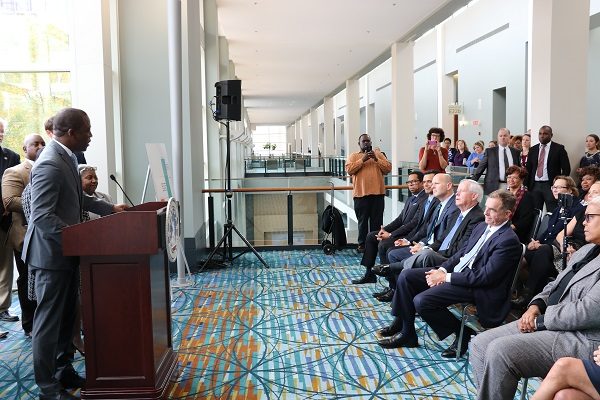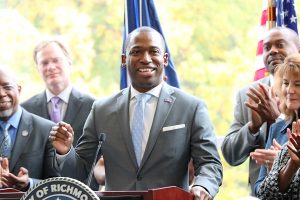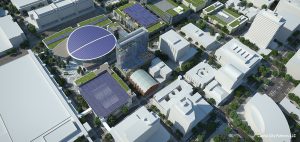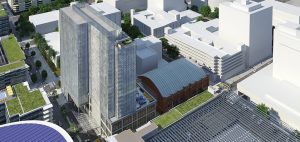
Mayor Levar Stoney announces his support for the project in front of NH District Corp. members (seated from right) Tom Farrell, C.T. Hill and others. (Charlotte Woods)
The proposal from a group of Richmond corporate heavyweights to redevelop the Coliseum and surrounding area north of Broad Street has the support of Mayor Levar Stoney, who announced Thursday his intention to send the $1.4 billion project to City Council for potential approval.
With the aging, nearly half-century-old arena visible behind him, Stoney formally threw his support behind the proposal by the Tom Farrell-led NH District Corp. at a gathering across the street in the Greater Richmond Convention Center.
Farrell, CEO of Dominion Energy, sat in front of and applauded Stoney alongside former SunTrust executive C.T. Hill and others involved in the lone proposal submitted in response to a city RFP put out last November, nearly a year to the day.
Stoney lauded the plan, now referred to as the Navy Hill neighborhood redevelopment, which would replace the Coliseum with a 17,500-seat arena and redevelop the 10-block area bounded by North Fifth, East Leigh, North 10th and East Marshall streets with 2,800 new housing units, including 2,520 market-rate apartments and 680 income-based units, and a 23-story, 527-room Hyatt Regency hotel to serve the convention center.
Plans also call for preserving and redeveloping the old Blues Armory building with a 20,000-square-foot food court plus entertainment and event spaces, replacing the GRTC transfer center along Ninth Street, and re-use of sites filled with outdated city buildings.
At $1.4 billion, Stoney said the overall investment would be the biggest economic development project in city history, to be funded in large part through the establishment of a tax-increment financing (TIF) district, in which real estate tax revenue from new development in the district would be used specifically to pay for the project.
The development is expected to generate $1 billion in additional tax revenue in 30 years, and Stoney said a third-party analysis by Chicago-based Hunden Strategic Partners – details of which were to be presented at a press briefing Friday – projected as much as $1.7 billion in tax revenue would be created from the project.
(Friday update: The $1.4 billion investment would consist of $1.1 billion in private development cost to be fronted by NH District Corp. and $300 million in non-recourse revenue bonds to be floated by the city. The bonds would be underwritten by JPMorgan Chase and Citigroup and paid back over 30 years using the $1 billion-plus in projected TIF revenue and $600 million in projected additional revenues the project would generate, such as sales tax revenue. Any surplus revenues would be distributed 50-50 to the city general fund and to paying off the bonds early, according to details shared in Friday’s press briefing.)
TIF puts the load on developers, bond holders
With the tax-increment financing, which would be managed by Union Bank, Stoney said the project would not impact the city’s tax rates or debt, nor would it require bond obligations from the city.
“The developers and bond holders will shoulder 100 percent of the risk for this project, and not the city,” Stoney said.

Stoney described the project as the biggest economic development investment in city history. (Charlotte Woods)
Stoney said the project would create more than 21,000 jobs – 12,500 during construction, 9,000 post-construction – and produce $300 million in contracts for minority businesses, one of several provisions he required the proposal to address.
Such commitments were made through negotiations with NH District Corp. that Stoney said lasted eight months. Local financial firm Davenport & Co. worked with the city in the process.
In addition to Farrell and Hill, the group includes former Altria CEO Marty Barrington and has commitments from Union Bank & Trust and The Community Foundation, which have pledged $1 million and $5 million, respectively, to the project’s income-based housing component. Local nonprofit Better Housing Coalition would oversee that part of the project.
The group has retained Fairfax-based Concord Eastridge and CEO Susan Eastridge, along with Michael Hallmark and his Los Angeles-based Future Cities, as master developers of the project.
Farrell said following the announcement that the new arena and Blues Armory would remain city-owned properties, while the rest of the properties would likewise be city-owned but leased out through long-term leases.
Farrell acknowledged the proposed TIF district has been expanded from the 10-block project area to include areas in neighboring Jackson Ward and south of Broad Street in Monroe Ward, as the Times-Dispatch reported earlier this week. The expanded area includes the new Dominion tower under construction on South Sixth Street and the site of a planned second tower nearby.
Farrell said the expansion was needed to include more property as the affordable housing component of the project increased – “to be able to literally find property inside the TIF district where we could build the affordable housing,” he said.
Of the 680 income-based units to be built as part of the project, 280 would be built within the 10-block project area and 200 would be built downtown. The remaining 200 would be constructed using TIF revenues specifically.
Regarding the project overall, Farrell said, “It’s been a long time coming. We’re very pleased.
“The mayor had bold vision, we had bold vision, and he had very worthy goals that we wanted to work with him on to get more affordable housing into the project, minority contracting opportunities, create the jobs, and we’re very pleased that we were able to accomplish all of that.”
‘This is why tax incremental-financing works’
In addition to contributing $1 million to the income-based housing component, Union Bank would make what CEO John Asbury called “a major sponsorship” associated with the project. He said details of that sponsorship, which would cover some of the project’s costs, would be disclosed at a later date.
Asbury, who said he has been involved in TIF projects previously and seen the funding method work for projects across the country, said the TIF district would be the first of its kind in Richmond.
“I am surprised, in 2018, Richmond has not seen this before,” Asbury said. “I’ve seen it work. Something that’s properly conceived, well-structured and well-managed, I have seen it work repeatedly across the United States. The operative term is incremental financing. This is an investment; this is why tax-incremental financing works.
“I am highly confident that the right players are involved, I’m highly confident in the plan. We will put our money where our mouth is to support this.”
Stoney said he would submit the proposal to City Council for consideration in coming weeks.
Note: This story has been updated and revised with details shared in a press briefing Friday.

Mayor Levar Stoney announces his support for the project in front of NH District Corp. members (seated from right) Tom Farrell, C.T. Hill and others. (Charlotte Woods)
The proposal from a group of Richmond corporate heavyweights to redevelop the Coliseum and surrounding area north of Broad Street has the support of Mayor Levar Stoney, who announced Thursday his intention to send the $1.4 billion project to City Council for potential approval.
With the aging, nearly half-century-old arena visible behind him, Stoney formally threw his support behind the proposal by the Tom Farrell-led NH District Corp. at a gathering across the street in the Greater Richmond Convention Center.
Farrell, CEO of Dominion Energy, sat in front of and applauded Stoney alongside former SunTrust executive C.T. Hill and others involved in the lone proposal submitted in response to a city RFP put out last November, nearly a year to the day.
Stoney lauded the plan, now referred to as the Navy Hill neighborhood redevelopment, which would replace the Coliseum with a 17,500-seat arena and redevelop the 10-block area bounded by North Fifth, East Leigh, North 10th and East Marshall streets with 2,800 new housing units, including 2,520 market-rate apartments and 680 income-based units, and a 23-story, 527-room Hyatt Regency hotel to serve the convention center.
Plans also call for preserving and redeveloping the old Blues Armory building with a 20,000-square-foot food court plus entertainment and event spaces, replacing the GRTC transfer center along Ninth Street, and re-use of sites filled with outdated city buildings.
At $1.4 billion, Stoney said the overall investment would be the biggest economic development project in city history, to be funded in large part through the establishment of a tax-increment financing (TIF) district, in which real estate tax revenue from new development in the district would be used specifically to pay for the project.
The development is expected to generate $1 billion in additional tax revenue in 30 years, and Stoney said a third-party analysis by Chicago-based Hunden Strategic Partners – details of which were to be presented at a press briefing Friday – projected as much as $1.7 billion in tax revenue would be created from the project.
(Friday update: The $1.4 billion investment would consist of $1.1 billion in private development cost to be fronted by NH District Corp. and $300 million in non-recourse revenue bonds to be floated by the city. The bonds would be underwritten by JPMorgan Chase and Citigroup and paid back over 30 years using the $1 billion-plus in projected TIF revenue and $600 million in projected additional revenues the project would generate, such as sales tax revenue. Any surplus revenues would be distributed 50-50 to the city general fund and to paying off the bonds early, according to details shared in Friday’s press briefing.)
TIF puts the load on developers, bond holders
With the tax-increment financing, which would be managed by Union Bank, Stoney said the project would not impact the city’s tax rates or debt, nor would it require bond obligations from the city.
“The developers and bond holders will shoulder 100 percent of the risk for this project, and not the city,” Stoney said.

Stoney described the project as the biggest economic development investment in city history. (Charlotte Woods)
Stoney said the project would create more than 21,000 jobs – 12,500 during construction, 9,000 post-construction – and produce $300 million in contracts for minority businesses, one of several provisions he required the proposal to address.
Such commitments were made through negotiations with NH District Corp. that Stoney said lasted eight months. Local financial firm Davenport & Co. worked with the city in the process.
In addition to Farrell and Hill, the group includes former Altria CEO Marty Barrington and has commitments from Union Bank & Trust and The Community Foundation, which have pledged $1 million and $5 million, respectively, to the project’s income-based housing component. Local nonprofit Better Housing Coalition would oversee that part of the project.
The group has retained Fairfax-based Concord Eastridge and CEO Susan Eastridge, along with Michael Hallmark and his Los Angeles-based Future Cities, as master developers of the project.
Farrell said following the announcement that the new arena and Blues Armory would remain city-owned properties, while the rest of the properties would likewise be city-owned but leased out through long-term leases.
Farrell acknowledged the proposed TIF district has been expanded from the 10-block project area to include areas in neighboring Jackson Ward and south of Broad Street in Monroe Ward, as the Times-Dispatch reported earlier this week. The expanded area includes the new Dominion tower under construction on South Sixth Street and the site of a planned second tower nearby.
Farrell said the expansion was needed to include more property as the affordable housing component of the project increased – “to be able to literally find property inside the TIF district where we could build the affordable housing,” he said.
Of the 680 income-based units to be built as part of the project, 280 would be built within the 10-block project area and 200 would be built downtown. The remaining 200 would be constructed using TIF revenues specifically.
Regarding the project overall, Farrell said, “It’s been a long time coming. We’re very pleased.
“The mayor had bold vision, we had bold vision, and he had very worthy goals that we wanted to work with him on to get more affordable housing into the project, minority contracting opportunities, create the jobs, and we’re very pleased that we were able to accomplish all of that.”
‘This is why tax incremental-financing works’
In addition to contributing $1 million to the income-based housing component, Union Bank would make what CEO John Asbury called “a major sponsorship” associated with the project. He said details of that sponsorship, which would cover some of the project’s costs, would be disclosed at a later date.
Asbury, who said he has been involved in TIF projects previously and seen the funding method work for projects across the country, said the TIF district would be the first of its kind in Richmond.
“I am surprised, in 2018, Richmond has not seen this before,” Asbury said. “I’ve seen it work. Something that’s properly conceived, well-structured and well-managed, I have seen it work repeatedly across the United States. The operative term is incremental financing. This is an investment; this is why tax-incremental financing works.
“I am highly confident that the right players are involved, I’m highly confident in the plan. We will put our money where our mouth is to support this.”
Stoney said he would submit the proposal to City Council for consideration in coming weeks.
Note: This story has been updated and revised with details shared in a press briefing Friday.






It’s an interesting project and the details have yet to be scrutinized by anyone . But they’re essentially asking the City to guarantee on a $1.4 billion dollar note. How much is the City’s budget? If the developers default the City is on the hook for the note? How will that effect the City’s bond rating taking on a industrial revenue bond that’s larger than the entire budget? How is the City going to make up the difference when the TIF takes away money from the tax rolls to fund this project, raise everyone’s taxes? Also where are the 15-20K… Read more »
Mr. Watson asks great questions. Many of the return revenue projections were posted when the City decided to build the convention center. Has it returned the investment?
Also, once again the Diamond and minor league baseball continues to be sidelined on the bench for a new shiny substitute. Many cities have combined coliseums and mlb stadiums on the same location to share parking, concessions etc. Anybody ask that question?
I was a little skeptical at first, but I have seen 2 presentations form the NH District Corp. and it seems very well planned out. The city is not guaranteeing anything. They are going to issue no recourse bonds only for the $300 million renovations to the Armory, the new Coliseum, and some infrastructure around the area, not the entire $1.4 billion. The developers and bond holders hold all the risk. If the project completely flops, the City will not be liable to the bond holders. Also, the TIF district takes ZERO in current revenue away from the City. Only… Read more »
Ive been trying to poke holes in this proposal for months, ala the Shockoe baseball proposal. that one was easy. This one has improvedto the point that I must support it, at least until more astute friends can point out its flaws. The new arena can produce income year round. we finally have adequate rooms downtown to produce a positive revenue on the convention center so lets bring the hotels more business. this project will help us avoid many of the issues that an economic downturn may cause. the timing is good. let’s move forward with it. I too am… Read more »
Tom – based on your comment, if “the TIF district takes ZERO in current revenue away from the City. Only the additional revenue from the increase of property taxes of the redeveloped area will be used to pay the bonds back. That property, which is all city owned” were correct, then why does the article mention “The expanded (TIF) area includes the new Dominion tower under construction on South Sixth Street and the site of a planned second tower nearby.” I’m not sure of your expertise in this (and I am claiming no expertise here myself), but it seems to… Read more »
William, I agree that expanding the TIF district to beyond the defined development area is a bit unsettling. The original presentations I saw did not include that expansion. I am not an expert in public financing. I have a very basic understanding. My guess would be that they expanded the TIF district to give the potential bond buyers more assurance they will be repaid since the City is not issuing a moral or general obligation to the bonds. Also, as Mr. Farrell explains, it would include a larger area to include for affordable housing. Originally they were planning 280 affordable… Read more »
I’m very skeptical as well. I feel the TIF area is far too big and will strangle the tax roll. And just in general the scope of this project is too big with its arena, hotel, bus transfer, housing, entertainment venue, food hall, etc for our city government to be involved in. The bigger they are the harder they fall/fail. I’m not sure the government needs to be directly involved in any of those things besides the bus transfer station. What would it cost for the city to build a new bus transfer station and just let the market determine… Read more »
“680 income-based units” = Low Income Housing Tax Credit (LIHTC) or HUD Section 8 units. Most LIHTC properties accept HUD Section 8 vouchers.
LIHTC properties are actually required to accept Housing Choice Vouchers. And yes, LIHTC is a large low-income housing program. What are you getting at with these facts, Tom?
The city of Richmond has a nearly 0% success rate with their flagship “build it and they will come” projects. 6th Street Marketplace, the Canal Walk, Valentine Riverside, the Convention Center, Stone Brewing, etc. Even Brown’s Island sits unused because Venture Richmond charges to much to rent it, although they use it for free. Recent growth in Richmond (Scott’s Addition, Manchester, craft breweries, restaurants, etc.) has been DESPITE city government, not BECAUSE of it. If the consensus feels we really need a new stadium, the City of Richmond needs to lease their land to a private entity who will take… Read more »
I understand the skepticism, but a city can’t sit idle just because other people failed in the past. We elect new mayors and city council people who in turn put different people into our government. Comparing Richmond today to the Richmond that caused the failure of 6th Street Marketplace and even the existing Coliseum is not productive. We are a completely different city than we were 20 years ago and I think it’s important to try and take advantage of this. This project is actually making an effort to put affordable housing in and create work for local contractors. These… Read more »
Tim you do realize MOST of the senior staff at the City are the same staff of the Jones Administration including all of the same Econ Dev staff. The same staff behind Redskins and Stone Brewing and the UCI Bike race. And the Broad Street CDA was the exact same SCAM. A entity established by and for the City Issues the bonds to build the public infrastructure and semi private development. then additional private investment will come and pay off the bonds. They built the public infrastructure but ran out of money to do the semi-private work, the private investment… Read more »
I think Karl is right on the money. The city failure rate with development projects, false projections, etc. is eye popping. I’m for the new coliseum but let’s do one project at a time and let private development do it – not the city. If we got the new coliseum, private development would build around this and then the tax dollars could be used for the schools. Not to mention the development would be much better and create a stronger tax base too. As for this proposal – wasn’t the mayor saying he wanted at least 1,500 affordable housing units… Read more »
So in the proposal the city will provide funds for the Coliseum and the Armory, that is all. Everything else will be private money. So the idea that the city builds a new Coliseum and then private development is attracted to fill in the rest is basically what is happening. In this case the city doesn’t have to front the money for the coliseum but will recoup it from future tax money provided by the private investment that is already on board. It is a risk as always, I agree, but if you are for a new Coliseum provided by… Read more »
I understand this sentiment, but I think there is evidence to the contrary. The Canal Walk was built in part because the city had to dig up the riverfront and install massive combined sewage overflow pipes. By putting them beneath the canal (where they can be serviced simply by draining the water) we got pipes as well as a recreational amenity. While not sparking an instant explosion of investment, it has drawn steady private investment over time since its completion. The project, in tandem with other public infrastructure such as construction of the T. Tyler Potterfield pedestrian bridge and the… Read more »
Richmond is a different place than it was back then. And there are knowledgeable people working in economic and community development who have the Citys interests at heart. However some things stay the same. It seems short sighted to sign a loan for $1.4 billion dollars effectively changing the entire financial system of our City. Does anyone know the amount of a $1.4 billion monthly mortgage payment? If the principle developers sign a personal guarantee and give the City the first lien position then maybe the project should move forward. But if the plan is to build something that’s effectively… Read more »
Why does the arena need to seat 17,500? That’s halfway between the capacity of the UVA basketball arena (14k) and the Washington DC arena (20k) where TWO major league teams play. VCU and UofR already have suitable arenas and we don’t even have a minor league team that would occupy it consistently. What are the intended purposes? A concert venue where they close off 1/3 of the arena anyway? Once a year Atlanic-10 conference basketball tournament? This building should be tailored to its ideal intended use, and I don’t foresee a real situation where 17,500 people get into downtown Richmond… Read more »
With the admitted numbers, the total project costs are being touted as $1.4 billion dollars with a portion being paid by the City and a majority being paid by developer. The TIF district will reserve a portion of real estate tax dollars downtown to pay for this project, $1 billion dollars. The City has to make that money up some where so they raise everyone’s taxes to pay for it. So now the project is costing the City $2.4 billion. Now add the mortgage interest payments on and you get a number over $5 billion. The numbers are adding up… Read more »
Paul, where are you getting $2.4 billion? It is very clear in the article that the city is paying for about $300 million of this project through the TIF. However, they are not on the hook for the bonds meaning none of the risk is on the city. I see it like going in on a house with someone but the mortgage is not in your name. You help make payments but if the loans is defaulted on it isn’t your responsibility. The City’s deal is even better however because they will still own the Coliseum and armory (the parts… Read more »
It should also be noted this is not removing existing taxed property from the rolls. It is Tax Increment Financing. The “Increment” in the name is there because only the taxes on the increment of the value of a property that increases because of the improvements goes toward this project. So, if a blank piece of land is worth $1 million now and someone puts a $9 million building on it then only 90% of the taxes would go towards retiring the debt, but that 10% would still go to the general fund. Either way they get the taxes for… Read more »
No the “Increment” is decided in a multitude of ways depending on how the deal is structured. What you are using is just one example of how deals like this are accomplished. The fact is its the City who is turning over $1 Billion in property taxes to finance the TIF district. Its the City that has to make up that money some how, presumably by raising taxes to pay for the $1 Billion property tax loss. Including the bonds the City is issuing, the developers are getting handed over 90% of the money to build the project. What is… Read more »
It has been stated that only the value of new development and not existing development would go towards debt payments. Please show us where it has been said differently. Made up numbers like $2.4 billion and $5 billion should not be thrown around without something to back them up.
Paul, again it is VERY clear in the article (“The $1.4 billion investment would consist of $1.1 billion in private development cost to be fronted by NH District Corp. and $300 million in non-recourse revenue bonds to be floated by the city.”) that the city is ONLY paying for about 300 million. Yes that goes up with interest. This will fund the new Arena and armory which the city will own not the developers. Therefore the city is literally just paying for what the city gets. It will use future tax money in the TIF area to pay back only… Read more »
Some questions come to mind. 1. Why on earth do we need a 17,500 seat arena that’s going to cost the city $500+M when all is said and done? 2. If this arena is such an important amenity for the region, why are city taxpayers having to go it alone? 3. How much is the public land that’s NH Corp is getting access to worth, and what does the city get in return? 4. Hw much will we be spending to replace the demolished city office buildings? I’m happy to see the rest of the development move forward, but I… Read more »
Ever heard of a bait and switch? Maybe I’m missing something but if the City dedicated a billion dollars in real estate taxes to this project, the money will have to be made up somewhere in the general fund, correct? The City is about to issue a $ 300 Million bond referendum to finance the construction of the armory and coliseum? So to me the City is essentially paying all the upfront costs for this project. I’m not questioning the project itself which has flaws- for example building almost 700 new section- 8 housing units in close proximity to some… Read more »
Seriously, you really aren’t reading the article. The $300 million isn’t going to the NH Group, its going to the cost of the arena and armory (as well as infrastructure improvements). BOTH OF WHICH THE CITY WILL OWN. Meaning NO MONEY will go to the NH group for that. The NH Group benefits from these amenities because they believe it will make the neighborhood more desirable. This is the only money the city is putting up, no more. Also, if you are questioning how this is funded you again aren’t paying attention. The TIF will fund it with future tax… Read more »
All I know is my real estate taxes increase dramatically every year to the point that I will probably be forced to leave the city soon. Furthermore, I refuse to believe that my quality of life is being diminished by the fact that Beyonce will not play Richmond.
My analysis of the new development proposal: “If you can’t dazzle ’em with brilliance, then baffle ’em with BS.”
I
Tim,
Don’t kid yourself that your taxes are for nothing. If it wasn’t for good folks like yourself who else would pay for the high $ salaries of the Ric Public School administrators ??
If we just get a few more out of state breweries in our folds I think the City will be flush with cash.
Let’s go!!!
P.s. Don’t forget to fire the auditors. We don’t have time to be bothered with pesky facts and oversight. We have taxes to raise.